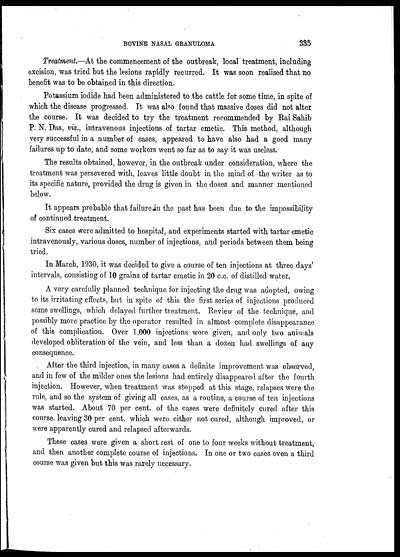Medicine - Veterinary > Veterinary colleges and laboratories > Indian journal of veterinary science and animal husbandry > Volume 1, 1931 > Part IV (December 1931) > Bovine nasal granuloma
(382) Page 335
Download files
Individual page:
Thumbnail gallery: Grid view | List view

BOVINE NASAL GRANULOMA 335
Treatment.—At the commencement of the outbreak, local treatment, including
oxcision, was tried but the lesions rapidly recurred. It was soon realised that no
benefit was to be obtained in this direction.
Potassium iodide had been administered to the cattle for some time, in spite of
which the disease progressed. It was also found that massive doses did not alter
the course. It was decided to try the treatment recommended by Rai Sahib
P. N. Das, viz., intravenous injections of tartar emetic. This method, although
very successful in a number of cases, appeared to have also had a good many
failures up to date, and some workers went so far as to say it was useless.
The results obtained, however, in the outbreak under consideration, where the
treatment was persevered with, leaves little doubt in the mind of the writer as to
its specific nature, provided the drug is given in the doses and manner mentioned
below.
It appears probable that failure in the past has been due to the impossibility
of continued treatment.
Six cases were admitted to hospital, and experiments started with tartar emetic
intravenously, various doses, number of injections, and periods between them being
tried.
In March, 1930, it was decided to give a course of ten injections at three days'
intervals, consisting of 10 grains of tartar emetic in 20 c.c. of distilled water.
A very carefully planned technique for injecting the drug was adopted, owing
to its irritating effects, but in spite of this the first series of injections produced
some swellings, which delayed further treatment. Review of the technique, and
possibly more practice by the operator resulted in almost complete disappearance
of this complication. Over 1,000 injections were given, and only two animals
developed obliteration of the vein, and less than a dozen had swellings of any
consequence.
After the third injection, in many cases a definite improvement was observed,
and in few of the milder ones the lesions had entirely disappeared after the fourth
injection. However, when treatment was stopped at this stage, relapses were the
rule, and so the system of giving all cases, as a routine, a course of ten injections
was started. About 70 per cent. of the cases were definitely cured after this
course. leaving 30 per cent. which were either not cured, although improved, or
were apparently cured and relapsed afterwards.
These cases were given a short rest of one to four weeks without treatment,
and then another complete course of injections. In one or two cases even a third
course was given but this was rarely necessary.
Set display mode to: Large image | Zoom image | Transcription
Images and transcriptions on this page, including medium image downloads, may be used under the Creative Commons Attribution 4.0 International Licence unless otherwise stated. ![]()
| Permanent URL | https://digital.nls.uk/75226941 |
|---|
| Description | Covers articles from 1931. |
|---|




